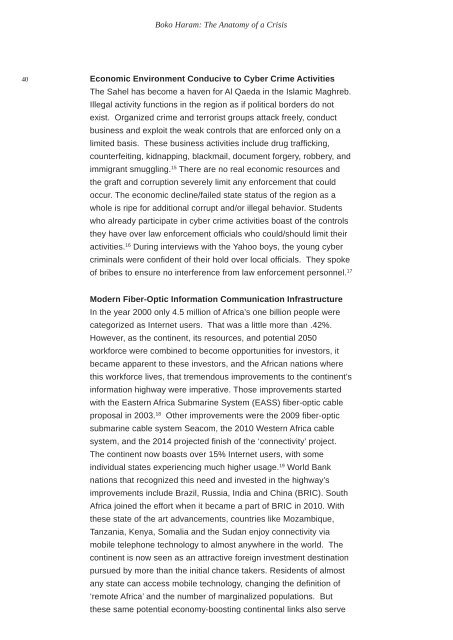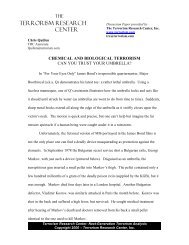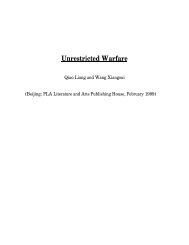Boko Haram Anatomy of a Crisis - Terrorism
Boko Haram Anatomy of a Crisis - Terrorism
Boko Haram Anatomy of a Crisis - Terrorism
Create successful ePaper yourself
Turn your PDF publications into a flip-book with our unique Google optimized e-Paper software.
<strong>Boko</strong> <strong>Haram</strong>: The <strong>Anatomy</strong> <strong>of</strong> a <strong>Crisis</strong><br />
Nigeria’s Vulnerability to Cyber Warfare<br />
40<br />
Economic Environment Conducive to Cyber Crime Activities<br />
as the tool for cyber criminals to advance their entrepreneurial skills.<br />
41<br />
The Sahel has become a haven for Al Qaeda in the Islamic Maghreb.<br />
Illegal activity functions in the region as if political borders do not<br />
exist. Organized crime and terrorist groups attack freely, conduct<br />
business and exploit the weak controls that are enforced only on a<br />
limited basis. These business activities include drug trafficking,<br />
counterfeiting, kidnapping, blackmail, document forgery, robbery, and<br />
immigrant smuggling. 15 There are no real economic resources and<br />
the graft and corruption severely limit any enforcement that could<br />
occur. The economic decline/failed state status <strong>of</strong> the region as a<br />
whole is ripe for additional corrupt and/or illegal behavior. Students<br />
who already participate in cyber crime activities boast <strong>of</strong> the controls<br />
they have over law enforcement <strong>of</strong>ficials who could/should limit their<br />
activities. 16 During interviews with the Yahoo boys, the young cyber<br />
criminals were confident <strong>of</strong> their hold over local <strong>of</strong>ficials. They spoke<br />
Cyber Warfare Attacks<br />
The attacks executed by the perpetrators <strong>of</strong> Stuxnet, Ghostnet, and<br />
even Flame, were initially conceived and deployed incognito. Flame<br />
functioned for almost two years before discovery, and when found,<br />
the United States did not initially acknowledge its role. The negative<br />
international response to Flame and Ghostnet was enough for<br />
nation-states to realize that today’s military strategy-international<br />
diplomacy equilibrium demands a more discreet employment <strong>of</strong> this<br />
new weapon. One that does not jeopardize current diplomatic<br />
relations or upset conventional weapons partners. The nations left<br />
vulnerable after each <strong>of</strong> these attacks also recognized that they<br />
would be at a disadvantage if they did not begin to include strategic<br />
cyber <strong>of</strong>fensive and defensive operations into their national defense<br />
<strong>of</strong> bribes to ensure no interference from law enforcement personnel. 17<br />
blueprint. While the Flame attack was directly attributed to the<br />
United States, the Ghostnet attack was never conclusively identified<br />
Modern Fiber-Optic Information Communication Infrastructure<br />
as China directed. The young researcher identified as Ghostnet’s<br />
In the year 2000 only 4.5 million <strong>of</strong> Africa’s one billion people were<br />
perpetrator was a well-known hacker who never implicated any other<br />
categorized as Internet users. That was a little more than .42%.<br />
person or entity in the effort.<br />
However, as the continent, its resources, and potential 2050<br />
workforce were combined to become opportunities for investors, it<br />
became apparent to these investors, and the African nations where<br />
this workforce lives, that tremendous improvements to the continent’s<br />
information highway were imperative. Those improvements started<br />
with the Eastern Africa Submarine System (EASS) fiber-optic cable<br />
proposal in 2003. 18 Other improvements were the 2009 fiber-optic<br />
submarine cable system Seacom, the 2010 Western Africa cable<br />
system, and the 2014 projected finish <strong>of</strong> the ‘connectivity’ project.<br />
The continent now boasts over 15% Internet users, with some<br />
individual states experiencing much higher usage. 19 World Bank<br />
nations that recognized this need and invested in the highway’s<br />
improvements include Brazil, Russia, India and China (BRIC). South<br />
Africa joined the effort when it became a part <strong>of</strong> BRIC in 2010. With<br />
these state <strong>of</strong> the art advancements, countries like Mozambique,<br />
Tanzania, Kenya, Somalia and the Sudan enjoy connectivity via<br />
mobile telephone technology to almost anywhere in the world. The<br />
continent is now seen as an attractive foreign investment destination<br />
pursued by more than the initial chance takers. Residents <strong>of</strong> almost<br />
any state can access mobile technology, changing the definition <strong>of</strong><br />
‘remote Africa’ and the number <strong>of</strong> marginalized populations. But<br />
these same potential economy-boosting continental links also serve<br />
What if a nation-state employed the tactic and this type <strong>of</strong> workforce<br />
on a future attack? That is: if a nation-state employed a third-party<br />
entity that is willing to NOT implicate the nation-state, could that<br />
nation-state successfully execute such a cyber warfare attack and<br />
not have to face the wrath <strong>of</strong> its international partners? Rafal<br />
Rohozinksi, one <strong>of</strong> the investigators <strong>of</strong> Ghostnet and c<strong>of</strong>ounder <strong>of</strong><br />
Information Warfare Monitor, has suggested that such outsourcing<br />
could become a wave <strong>of</strong> the future. Rohozinksi cites the factors that<br />
could contribute to the trend. Nations need an alternative that <strong>of</strong>fers<br />
anonymity preserves current diplomatic balances and employs<br />
resources that are outside the nation’s jurisdiction. According to a<br />
2011 Harvard School <strong>of</strong> Public Health assessment Africa is expected<br />
to contribute 49% <strong>of</strong> the world’s 2050 population growth. Rohozinski<br />
insists this 2050 workforce will have a demographic that is conducive<br />
to cyber crime: young, talented, from a developing nation,<br />
possessing a value system that has previously, and would in the<br />
future, support participation in or instigation <strong>of</strong> acts <strong>of</strong> cyber crime. If<br />
Rohozinski is correct, then we have to recognize that developing<br />
nations without strong ICT rules and regulation enforcement, nations<br />
with civil unrest or nations that lack services could serve as third<br />
party locations and perpetrator source.







